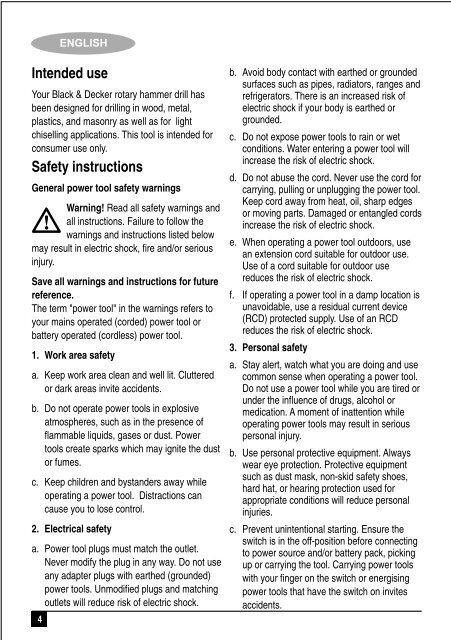BlackandDecker Trapano Percuss Rot- Kd750 - Type 1 - Instruction Manual (Inglese - Arabo)
BlackandDecker Trapano Percuss Rot- Kd750 - Type 1 - Instruction Manual (Inglese - Arabo)
BlackandDecker Trapano Percuss Rot- Kd750 - Type 1 - Instruction Manual (Inglese - Arabo)
You also want an ePaper? Increase the reach of your titles
YUMPU automatically turns print PDFs into web optimized ePapers that Google loves.
ENGLISH<br />
Intended use<br />
Your Black & Decker rotary hammer drill has<br />
been designed for drilling in wood, metal,<br />
plastics, and masonry as well as for light<br />
chiselling applications. This tool is intended for<br />
consumer use only.<br />
Safety instructions<br />
General power tool safety warnings<br />
Warning! Read all safety warnings and<br />
all instructions. Failure to follow the<br />
warnings and instructions listed below<br />
may result in electric shock, fire and/or serious<br />
injury.<br />
Save all warnings and instructions for future<br />
reference.<br />
The term "power tool" in the warnings refers to<br />
your mains operated (corded) power tool or<br />
battery operated (cordless) power tool.<br />
1. Work area safety<br />
a. Keep work area clean and well lit. Cluttered<br />
or dark areas invite accidents.<br />
b. Do not operate power tools in explosive<br />
atmospheres, such as in the presence of<br />
flammable liquids, gases or dust. Power<br />
tools create sparks which may ignite the dust<br />
or fumes.<br />
c. Keep children and bystanders away while<br />
operating a power tool. Distractions can<br />
cause you to lose control.<br />
2. Electrical safety<br />
a. Power tool plugs must match the outlet.<br />
Never modify the plug in any way. Do not use<br />
any adapter plugs with earthed (grounded)<br />
power tools. Unmodified plugs and matching<br />
outlets will reduce risk of electric shock.<br />
4<br />
b. Avoid body contact with earthed or grounded<br />
surfaces such as pipes, radiators, ranges and<br />
refrigerators. There is an increased risk of<br />
electric shock if your body is earthed or<br />
grounded.<br />
c. Do not expose power tools to rain or wet<br />
conditions. Water entering a power tool will<br />
increase the risk of electric shock.<br />
d. Do not abuse the cord. Never use the cord for<br />
carrying, pulling or unplugging the power tool.<br />
Keep cord away from heat, oil, sharp edges<br />
or moving parts. Damaged or entangled cords<br />
increase the risk of electric shock.<br />
e. When operating a power tool outdoors, use<br />
an extension cord suitable for outdoor use.<br />
Use of a cord suitable for outdoor use<br />
reduces the risk of electric shock.<br />
f. If operating a power tool in a damp location is<br />
unavoidable, use a residual current device<br />
(RCD) protected supply. Use of an RCD<br />
reduces the risk of electric shock.<br />
3. Personal safety<br />
a. Stay alert, watch what you are doing and use<br />
common sense when operating a power tool.<br />
Do not use a power tool while you are tired or<br />
under the influence of drugs, alcohol or<br />
medication. A moment of inattention while<br />
operating power tools may result in serious<br />
personal injury.<br />
b. Use personal protective equipment. Always<br />
wear eye protection. Protective equipment<br />
such as dust mask, non-skid safety shoes,<br />
hard hat, or hearing protection used for<br />
appropriate conditions will reduce personal<br />
injuries.<br />
c. Prevent unintentional starting. Ensure the<br />
switch is in the off-position before connecting<br />
to power source and/or battery pack, picking<br />
up or carrying the tool. Carrying power tools<br />
with your finger on the switch or energising<br />
power tools that have the switch on invites<br />
accidents.
















